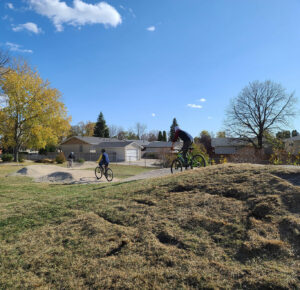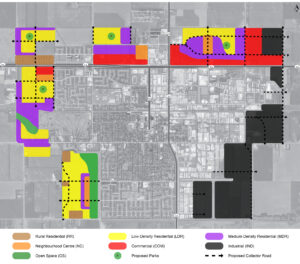After one of the most challenging years in recent memory, communities in Manitoba are looking to recover from the effects of the COVID-19 pandemic and return to a safe, vibrant, and sustainable society. Municipalities have played a crucial role in responding to the ongoing public health emergency by delivering services and setting policy for their citizens. When the need was most urgent, the collective actions of public and private sector professionals, especially our healthcare workers, helped ensure our communities were healthy and secure.
The immeasurable hardships of this pandemic, in many ways, revealed priorities that municipalities will need to consider moving forward. We asked community planners from Urban Systems’ Winnipeg practice – Shoni Madden, Angie Mojica, and Michael Wakely – what they heard and observed from their work with local government clients, as well as their thoughts on creating resilient communities from a planning context.



What have you heard from local government officials about their biggest challenge leading through a pandemic?
Shoni: I heard a lot of very different experiences from local governments. One of the biggest challenges that comes to mind was navigating decision-making and quickly adapting to changing public health restrictions. Many local governments tried new things to create space for social distancing in their communities. These included public spaces, safe active transportation options, cueing space for transit, recreation space, and improving access to local businesses. The shift required many people to work in new ways, being creative and quickly implementing solutions. The result meant not always getting it right on the first try!
Angie: The pandemic has really exacerbated social challenges in many of our communities, such as those around affordable housing, mental health, and poverty. It is also important to acknowledge that certain populations have been disproportionately impacted by the pandemic, including Black, Indigenous, and People of Colour (BIPOC), people experiencing housing vulnerabilities and homelessness, people with disabilities, and seniors. While such challenges are often outside of the mandate of local governments, there are many ways they can help to address their communities’ core needs.
Mike: One of the biggest challenges I heard has been the negative effect on community groups and their revenues. In many instances, community groups are responsible for managing and operating community facilities and user fees are the primary source of revenue. The importance of the social services and space community groups provide to communities can not be understated. While they are run by a dedicated core, they don’t typically have the resources or flexibility to adapt to restrictive conditions presented by the pandemic. This is indeed a common theme across the board: adaptability. Some have been quite adept while others have had a hard time, particularly with technology.
What were their most important takeaways after facing these challenges?
Shoni: A few key ingredients helped communities that have thrived in this challenge: support and understanding from Council, good monitoring, listening and adapting to feedback, and increased collaboration with partners (Public Health, NGOs, local businesses etc.).
Angie: Building off what Shoni said, local governments can have a key role in coordinating and bringing different partners together to address social challenges in their communities. They can work with various partners to coordinate and share resources, raise awareness, and educate community members to help generate public support. Multiple local governments can also work together and advocate to higher levels of government for additional support and funding.
Mike: Leadership, dialogue, partnerships, adaptability and resources. These have been key to weathering the storm. Now as we get closer to emerging from the pandemic, planning for a path forward becomes more important. Each community will be reflecting on where the opportunities and constraints exist. I think there will be more of an appetite to facilitate new initiatives intended to improve and expand community infrastructure, particularly the kind that leverages outdoor amenities and natural features.
What are some interesting projects or initiatives you have been involved with during Covid?
Shoni: I am part of a grants review committee for the Canadian Healthy Communities Initiative, a $31M federal grant which supports communities disproportionately impacted by COVID-19 with funds to cover improvements to public space, mobility, and digital solutions. The second round of funding is now open and closes on June 25, 2020, so get your applications in!
Angie: Our Winnipeg team has recently worked with Health Canada on research around better integrating public health and planning. This project involved a national survey and follow-up interviews with health professionals and planners. One of the key findings emerging from our research was a strong desire for increased collaboration between both professions. In particular, many projects can benefit by involving health professionals earlier in the process, as opposed to just providing a review from a health perspective.
Mike: We have been working with a community partner think through a project that would create a network of open green spaces in a neighbourhood that has a real lack of these kind of spaces. The need and benefits of outdoor green spaces in close, walking proximity to where people live has always been essential for a livable environment, but the pandemic has accentuated the need. With grant programs targeting community health and infrastructure initiatives, community groups can now help to change their environment for the better.

From a planning perspective, what are the most important lessons from the last 18 months?
Shoni: A healthy built environment is a key determinant of health, and that includes social and emotional well-being. After the early weeks of the pandemic, many saw their local neighbourhoods with fresh eyes. The way your neighbourhood is designed, your access to parks, greenspace, healthy food, affordable housing, safe active transportation and transit options directly shapes your ability to lead a healthy life. The pandemic forced us to see more clearly the inequities that exist in our communities. Not all Manitobans have an equal opportunity to lead a healthy life. The socio-economic, cultural, and environmental factors in which people grow – the social determinants of health enable certain individuals have better access to the resources they need to lead healthy lives. Those who continue to experience marginalization and discrimination in our communities need to be prioritized in all the planning work we do.
As we move forward, we need to ensure these key elements and increase our focus on areas that have been historically underserved. Ensure underserved communities have an equal opportunity to lead healthy lives, and that key services (childcare, education) and supports are accessible.
Angie: An increasing number of local governments and organizations have had a growing interest in pursuing projects related to social equity, including developing plans to address racism, accessibility, and homelessness. Some municipalities throughout the country have been reviewing their existing plans, such as their zoning by-law, and incorporating social equity into their decision-making process — which is awesome and I hope this continues to be an area of focus for local governments moving forward!
Mike: I always come back to this quote: we shape our environment, and then the environment shapes us. I believe more than ever there is a wilingness and an impetus to plan and shape our environment for health and social connectiveness on a human scale within our neighbourhoods.
What does a resilient community look like in the future?
Angie: As I mentioned earlier, while we have all experienced challenges over the last year as a result of the pandemic, certain demographics have been more significantly impacted. Our communities can come out of the pandemic stronger if we provide better supports to populations that have been underserved and misserved in the past. Resilient communities can use the pandemic as an opportunity for transformation — to form stronger partnerships across sectors and all levels of government to ensure everyone has access to the resources and supports they need to thrive.

Shoni: The ability to recover quickly from this is a key focus for all of us. Resilient communities will not turn away from the lessons taught to us during this pandemic. Working to address these shifts in understanding and values to ensure we all have the opportunity for health, social, and economic supports we need to live. Resilient communities will work with partners across all levels of government, and sectors to be mitigate the impacts of climate change and future health emergencies.
Mike: Never waste a crisis to bounce back better. Community resilience is the ability to adapt to sudden changes through administrative and infrastructural flexibility, partnerships and communication between leadership, administration and community members. The role of governments is to bolster their communities by providing resources and effective and adaptable policies. True resilience is on a much finer grain scale: the local neighbourhood scale. Planning and developing community capacity more locally will strengthen our communities and society as a whole.